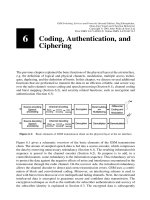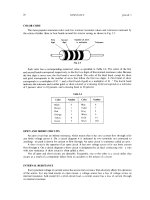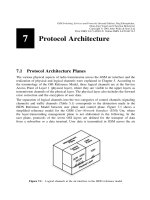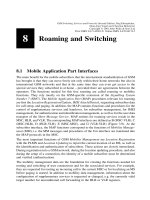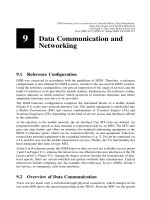Circuit Switching pot
Bạn đang xem bản rút gọn của tài liệu. Xem và tải ngay bản đầy đủ của tài liệu tại đây (1.18 MB, 38 trang )
Circuit Switching
by
Dr. Nguyen Minh Hoang
March 2007
References
Reference books:
Data Communications and Networking, 4/e, by Behrouz A.
Forouzan, DeAnza College
(raw-
hill.com/sites/0072967757/information_center_view0/)
Data & Computer Communications
by William Stallings (
/>
Introduction
How can we connect multiple devices?
Point-to-point vs.
Multipoint
Better solution switching
Switches: hardware and/or software
devices allowing temporary connections
between two or more devices
Three methods: circuit, packet, and
message
Example of a Switched Network
Circuit Switching
Creates a direct physical connection
between two devices
Originally developed for voice traffic
Does not use point-to-point connections
between every device to every other device
Instead, devices link to a switch which may
in turn link to other switches
Allows for a dedicated connection for
duration of transmission
Circuit Switching
Space-division switching
Time-division switching
TDM Bus
Combinations
Circuit switching: create a
direct physical connection
between 2 devices such as
phones or computers
Circuit Switch vs. Folded Switch
n inputs, m
outputs
n lines in full duplex
Folded Switch: An
n
-by
-n
folded switch allows every
device to connect to every
other device in full-duplex
mode
Space-Division Switch
The paths in the
circuit are separated
from each other
spatially
Originally for analog
networks, but now for
both analog and digital
Crossbar switch
Multistage switch
Crossbar Switch
Inputs and outputs
connected in a grid using
electronic microswitches
(transistors) at crosspoints
Disadvantage???
Too many crosspoints, only a
few used at any given time
Inefficient; fewer than 25%
of switches are in used at a
given time
Multistage Switches
Combine crossbar switches in several
stages
Devices are linked to switches that are
linked to a hierarchy of other switches
Middle stages usually have fewer switches
than first and last stages
Fewer crosspoints but still allowing multiple
paths through the network increased
reliability
Multistage Switch (1)
A set of crossbar switches in several stages
Use a 15x15 crossbar => 225 crosspoints
Use the above multistage =>78 crosspoints
Multistage Switch
Multiple paths available for each pair of devices => reliable
Blocking problem when heavy traffic,
experienced in public phone systems
Disadvantage???
Blocking
Reduced number of crosspoints may
mean that at times of heavy traffic, an
input may not be able to connect to an
output if there is no path available (i.e.
all switches are occupied)
Does not occur in single-stage switch; a
non-blocking path is always available
Time-Division Switches
Uses time-division multiplexing to achieve switching
Used by most modern switches
TD switching involves partitioning low speed bit
stream into pieces that share higher speed stream
Two methods:
Time-slot interchange (TSI)
TDM bus
Based on synchronous time division multiplexing (TDM)
Each station connects through controlled gates to high speed
bus
Time slot allows small amount of data onto bus
Another line’s gate is enabled for output at the same time
TDM with a Time Slot
Interchange
Without a TSI, order is unchanged
1->3, 2->4, 3->1, 4->2
Time Slot Interchange (TSI)
#memory locations = # inputs
size of mem. loc. = size of a time slot
Cannot handle
bursty traffic
Consists of RAM with
several memory
locations
Fills up with incoming
data from time slots
in order received
Slots are sent out in
order based on
control unit logic
TDM Bus
Input and output
lines are connected
to a high-speed bus
through input and
output gates
Control unit opens
and closes gates as
needed
Time vs. Space Division Switch
Time division
No crosspoints
Delay
Space division
Many crosspoints
Zero delay
Space- and Time-Division
Switching Combinations
Advantage of space-division switching is it is
instantaneous; however, requires too many
crosspoints
Advantage of time-division switching is it
needs no crosspoints; however, processing
connections creates delays
Combining them optimizes the number of
crosspoints and reduces the amount of delay
TSS: Time-Space-Space
TSST: Time-Space-Space-Time
STTS: Space-Time-Time-Space
TST Switch
Telephone Networks
1876: Alexander Graham Bell patented the telephone
1878: Bell Telephone Company first operated
1984: AT&T breakup => AT&T Long Lines and 23 Bell Operating
Companies, and a few other pieces
Since 1996: Any company can provide local or long-distance services
Telephone Network Structure
~22,000 end offices in US, each having up to 10,000 local loops
Local loop: analog 1-10km => how far is it if we stretch out all the
local loops in the world?
Trunks between switching offices: coax, microwave, fiber optics
All trunks and switches are now digital
Major Components
Local loops – twisted-pair cable connecting
subscriber phone to nearest end office or local
central office
Bandwidth of 4000 Hz (4 KHz)
Trunks – transmission media that handles
communication between offices
Muxing through optical fibers or satellite links
Switching Office – connects local loops or
trunks allowing connections between
subscribers
Major Components
LATAs
Local Access and Transport Area – defines
the boundary of a service area
Intra-LATA services are provided by local
exchange carriers (LEC)
Incumbent local exchange carriers
Competitive local exchange carriers
Communication is handled by end switches
and tandem switches

